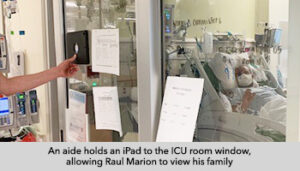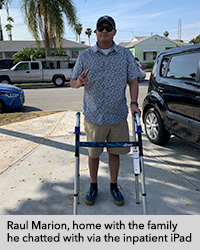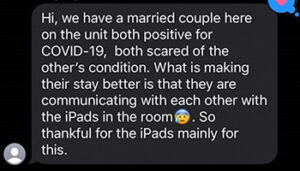No one thinks technology has a tender side (or even thinks about this at all). But a cross-departmental team of industrious Kaiser Permanente Southern California IT professionals discovered it – unknowingly.
When the “No Visitors” policy was instituted early in the COVID-19 crisis, patients were disconnected from their dearest, most vital support systems, just when they were most needed.
The logical solution? iPads. Then things got complicated.
As Alfred Velasquez, area information officer, Care Delivery Technology Services (CDTS) recalls, acquiring, configuring, distributing, and putting the devices into use required an extensive group effort, involving 6 IT and clinical/operations departments. “The team quickly got together and mapped out the solution. What followed was a lot of hard work and a little luck,” he said.
Some iPads are in use for patient education or appointment registration, but they’re not universally available, and couldn’t be reconfigured for external communications. Meanwhile, tablets suddenly became a high-demand, rare commodity. “Our purchasing sources depleted their entire inventory within the first couple weeks of the outbreak,” stated Velasquez.
Solidarity and Serendipity
Here’s where KP’s interdependency became a literal lifesaver. “We cast a wide net to query if any departments had iPads we could leverage,” explained Velasquez. The Systems Solutions & Deployment (SSD) group came through. They had recently acquired 800 iPads for another purpose, and could loan them to the patient communications initiative.
“Because KP is a relationship-based organization. we were able to make things happen quickly,” said David Campos, senior director, IT Business Operations, SSD. This solid partnership, good fortune, and fast-tracked leadership approvals shaved off several weeks typically required for proposals, financing, and acquisition.
Recognizing that Facetime (seamlessly integrated with iPads) would exclude Android users, the teams brainstormed and tested agnostic options, selecting Healthcare Anywhere, Vidyo, and Google Hangout. Next, the CDTS, SSD, Telehealth, Kaiser Permanente HealthConnect®, Nursing Informatics, and Patient Care teams sped from planning to implementation:
- Configuring the iPads and verifying secure network accessibility
- Installing the software and testing each app on each unit
- Verifying that all privacy, compliance, and regulatory needs were met
- Installing the tablets in cases; asset-tagging; scanning; re-packing; and labelling for delivery
- Developing training aids for patients and KP employees who would facilitate use
- Providing instructions for post-use decontamination and credential-wiping
Many Irons, Many Fires, and All Hands on Deck
Throughout, these IT employees were simultaneously managing many other major projects, including readying the Los Angeles Surge Hospital’s tech needs. Like many of us, they were working 14+ hour days – weekends included.
“Everyone told me, ‘Whatever you need – day or night. I’m here,’ recalled Campos. “No one spoke openly about the impact this will have on people’s lives, but everyone got it.”
For expediency, team members personally drove the iPads from Pasadena to the medical centers. Downey Medical Center was experiencing a surge of coronavirus patients and got the first delivery. Weeks later, upon Downey patient Raul Marion’s discharge, he credited the iPads as part of the “team” that gave him hope and strength to battle the virus. “Being told I was going to be put on a ventilator was really scary,” Marion said. “But the doctors did not give up. They made me feel like I could beat this.” Finally off the ventilator, Marion’s physician helped set up a video chat with his family. “It was great to see my fiancé and my kids. I missed them a lot. I told them, ‘I’m still fighting.’”
The iPads also enabled physicians to virtually visit patients, thereby “reaching” patients in life-saving minutes and preserving PPE – unnecessary for a virtual visit.
Feeling the Impact
Both Velasquez and Campos agreed that this project deeply impacted everyone involved. “Honestly, we’re usually working so fast or so remotely that we don’t get a chance to think about the ultimate purpose of the work. Being able to connect patients with families and immediately see the value of that took it to the next level,” remarked David Campos.
One nurse’s email brought it all home: “Hi, we have a married couple here on the unit, both positive for COVID-19, both scared of the other’s condition. What is making their stay better is that they are communicating with each other with the iPads in the room. So thankful…”
Alfred Velasquez shared a screen shot of that comment widely. “It helped us connect those long hours to the people we were helping.”
And there it is: the tender side of tech.


